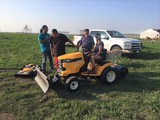South Dakota
 Tatanka Ki Owetu, the Renewal, AgrAbility Project on Pine Ridge, is working with 18 tribal clients on the Pine Ridge Reservation in South Dakota, as well as connecting seen non-tribal clients with partner resources. The project had over 55 tribal members participate in their rolling series of high-tunnel building and production workshops on Pine Ridge and to date, five of the team's clients are in various stages of planning or ordering their high-tunnels to begin production this season.
Tatanka Ki Owetu, the Renewal, AgrAbility Project on Pine Ridge, is working with 18 tribal clients on the Pine Ridge Reservation in South Dakota, as well as connecting seen non-tribal clients with partner resources. The project had over 55 tribal members participate in their rolling series of high-tunnel building and production workshops on Pine Ridge and to date, five of the team's clients are in various stages of planning or ordering their high-tunnels to begin production this season.  It's a bit late, but mother nature has been dealing a rough hand on the reservation with continued flooding and mud issues. The team is working with a mixture of physical, mental, behavioral, developmental, and cognitive disabilities, and are developing an adaptation of NAP's demographic collection tool. It's the same as the tool other SRAPs use, however, staff is adding more detailed information on mental, behavioral, cognitive, and developmental disabilities, and also allowing tribal members to state what their tribal affiliation is.
It's a bit late, but mother nature has been dealing a rough hand on the reservation with continued flooding and mud issues. The team is working with a mixture of physical, mental, behavioral, developmental, and cognitive disabilities, and are developing an adaptation of NAP's demographic collection tool. It's the same as the tool other SRAPs use, however, staff is adding more detailed information on mental, behavioral, cognitive, and developmental disabilities, and also allowing tribal members to state what their tribal affiliation is.
 In addition, two of the three planned AgrAbility incubator hubs for beginning farmers with disabilities are established, each with an outdoor teaching garden. One site, Rebel Earth Farms Incubator on the eastern side of the Reservation, has four 30'x100' High-tunnels and outdoor incubator plots for landless Lakota Tiwahe (family) farmers to use for free. This incubator space focuses primarily on mental, behavioral, cognitive and developmental disabilities.
In addition, two of the three planned AgrAbility incubator hubs for beginning farmers with disabilities are established, each with an outdoor teaching garden. One site, Rebel Earth Farms Incubator on the eastern side of the Reservation, has four 30'x100' High-tunnels and outdoor incubator plots for landless Lakota Tiwahe (family) farmers to use for free. This incubator space focuses primarily on mental, behavioral, cognitive and developmental disabilities.  Clients to date are learning to build and produce inside a high-tunnel environmental and are living with a variety of disabilities including Bi-Polar disorder, schizophrenia, drug and alcohol addiction, sexual assault, domestic assault and/or combat related PTSD, adverse childhood experiences, depression, toxic levels of stress, anxiety, panic attacks, and FAS (fetal alcohol syndrome). The second incubator-hub,
Clients to date are learning to build and produce inside a high-tunnel environmental and are living with a variety of disabilities including Bi-Polar disorder, schizophrenia, drug and alcohol addiction, sexual assault, domestic assault and/or combat related PTSD, adverse childhood experiences, depression, toxic levels of stress, anxiety, panic attacks, and FAS (fetal alcohol syndrome). The second incubator-hub,  Feather II, managed by partner Re-Member, also has two high-tunnels and a teaching garden but will focus mostly on working with clients with physical disabilities. The team is designing these high-tunnels to showcase a variety of ways to set up high-tunnel production to assist clients with a variety of physical and mobility disabilities.
Feather II, managed by partner Re-Member, also has two high-tunnels and a teaching garden but will focus mostly on working with clients with physical disabilities. The team is designing these high-tunnels to showcase a variety of ways to set up high-tunnel production to assist clients with a variety of physical and mobility disabilities.
Submitted by Jason Schoch
